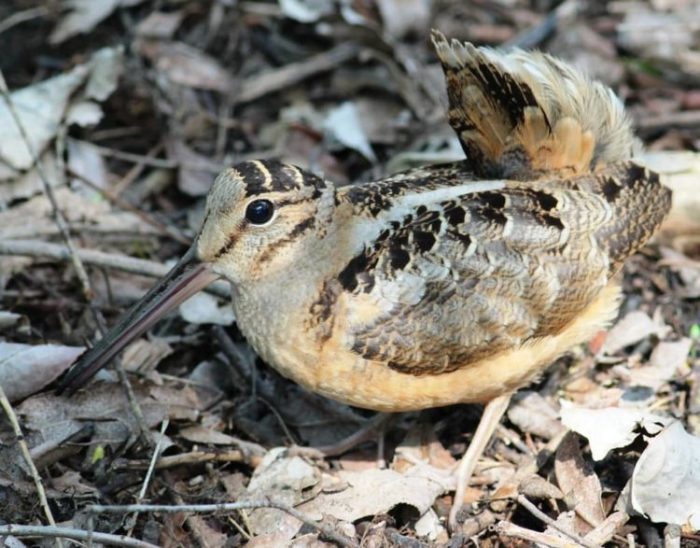
By Rochelle Thomas
It is with great pleasure and excitement that I introduce myself as the new Audubon Executive Director in Greenwich. I am honored to have the opportunity to serve this wonderful community and work towards a more sustainable and vibrant future. The town has a rich history and is home to many diverse ecosystems, including forests, wetlands, and coastal areas. These habitats are essential for the survival of many bird species, and it is our privilege to enjoy and protect them for generations to come.
Spring is just around the corner and on most nights here at the Greenwich Audubon Center, a strange sound fills the dusk air. A nasal “beent, beent, beent” is how author and illustrator David Allen Sibley describes the sound of the American woodcock a.k.a timberdoodle, a.k.a. a.k.a Scolopax minor, but I’ve always thought a more accurate description to be somewhere in the range of basic sock puppet talk. In the forests where they usually dwell, woodcocks are nearly impossible to see — except for when they perform their mating dance. At twilight, the male birds can be seen spiraling through the sky, their wings emitting a twittering sound before tumbling back down to earth.
In a week or two, this great spectacle will unfold right here at the Greenwich Audubon Center. We invite interested woodcock watchers to join us on Friday, March 17 at 6:45 and Saturday, March 18 at 6:45 to witness this magical courtship flight.
Early successional habitat, like what we have here in the area adjacent the Greenwich Audubon Center is exactly the type of habitat American woodcocks prefer for their wild displays. And the young forest habitat that keeps the timberdoodles talking is also essential for a host of other species that can be found on our property, like bobcat, Indigo Bunting, and maybe even the rare New England cottontail. While the International Union for the Conservation of Nature and Natural Resources (IUCN)’s 2021 assessment of American woodcock categorizes it as a species of Least Concern, their numbers are decreasing annually, with habitat loss as the likely blame.
Creating and maintaining the best possible habitat for birds is one of the goals we are constantly trying to achieve at the Greenwich Audubon Center. Our current efforts include a large-scale invasive species removal plan that will eliminate many of the most aggressive plants on our properties – privet, multiflora rose, and porcelain vine to name a few. In their place Virginia rose, Virginia creeper, and nannyberry viburnum will soon grow. Come and help! We always welcome volunteers.
There are also a multitude of things that you can do at home to protect birds in your backyard habitat. Each year, up to 1 billion birds are killed due to window collisions in the United States. Glass surfaces, particularly those that are reflective or transparent, present a significant hazard for birds. Lights and bright city skies at night also contribute to bird fatalities. Fortunately, there are do-it-yourself options to make homes safer for birds.
Reducing reflective surface collisions is one way to make glass surfaces more visible to birds. Creating patterns on reflective glass surfaces or installing external screens on windows are effective options. Closing blinds or curtains and moving interior plants away from windows can also help.
Placing bird feeders directly on windows is another way to minimize bird collisions.
Turning off unnecessary lights around buildings, making them motion activated, and ensuring they point toward the ground can also help to reduce the impact on migrating birds.
Adding native plants to your backyard is also a simple and effective way to support local bird populations, including the fascinating woodcock. Native plants are particularly important for birds and other wildlife because they have evolved to thrive in the local climate and provide food and shelter for native insects and other small animals. These insects, in turn, are a crucial source of food for birds.
In addition to providing food and shelter, native plants can also help to improve the overall health of your backyard ecosystem. They are often more resistant to pests and diseases than non-native plants, and they require less water and fertilizer to thrive reducing your environmental impact and creating a more sustainable and resilient landscape.
Some popular native plants for bird-friendly backyard landscaping in Greenwich and the northeast include the American elderberry, the red chokeberry, the eastern red cedar, and the black-eyed Susan. These plants provide a variety of benefits for birds, including berries for food, dense foliage for shelter and nesting sites, and flowers for nectar and pollen.
If you are interested in incorporating native plants into your backyard landscaping, there are many resources available to help you get started. Our Plants for Birds program can help you bring wildlife into your own space. In addition, while I am a relative newcomer to town, I am already aware of the depth of resources our local garden clubs provide.
Regardless of what actions you take to help wildlife this spring, I hope you do take time to enjoy all that nature has to offer in quite possibly, the most vibrant season. While the woodcock’s beent is perhaps the true harbinger of spring, the house finches singing loudly behind my desk beg to differ.
Rochelle Thomas is the Director of the Greenwich Audubon Center. She recently received a master’s in Ecology, Evolution and Environmental Biology where her research focused on Lesser Snow Geese.




